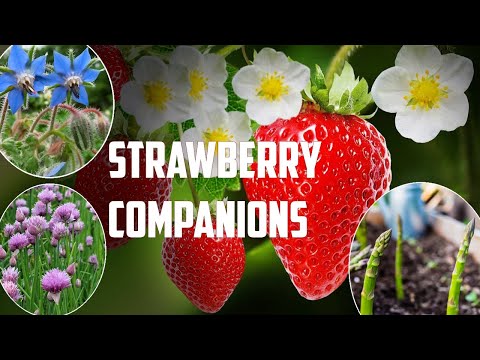Growing strawberries can be a great way to add some sweetness to your garden. However, it is important to be mindful of what you plant near your strawberry plants. Certain vegetables, herbs, and flowers can have a detrimental effect on your strawberry crop if planted too close. In this article, we will discuss which plants should not be planted near strawberries and why.It is not recommended to plant vegetables such as tomatoes, potatoes, peppers, eggplants, squash, and cucumbers near strawberries. These plants are susceptible to the same pests and diseases that can affect strawberry plants. Additionally, some vegetables can compete with strawberries for water and nutrients in the soil. To prevent this competition and potential disease transfer, it is best to keep these two types of plants separate in your garden.
Herbs To Avoid Planting With Strawberries
When growing strawberries in your garden, it is important to choose companion plants that will benefit the health and growth of your strawberry plants. However, there are some herbs that should be avoided when planting strawberries. These herbs can inhibit the growth of the strawberries, leading to poor yields and other problems. Therefore, it is important to be aware of which herbs to avoid planting with strawberries for successful gardening results.
One herb to avoid planting with strawberries is mint. Mint can spread rapidly and can easily take over a garden bed, competing with the strawberry plants for resources such as water and nutrients. In addition, mint has a strong aroma which can alter the taste of the strawberries if planted too close together. Similarly, fennel should also be avoided when planting strawberries due to its invasive nature and ability to overpower other plants in its vicinity.
Rosemary is another herb that should not be planted alongside strawberry plants due to its strong scent and flavor which can affect the taste of the berries if planted too close together. In addition, rosemary requires high amounts of sunlight compared to other herbs, which could cause a competition for sunlight between rosemary and the strawberry plants. Finally, sage should also be avoided when planting strawberries as it is known to attract certain pests that may feed on the strawberry fruits or leaves in large numbers.
In conclusion, it is important to consider which herbs should be avoided when planting strawberries in order for successful gardening results. Mint, fennel, rosemary and sage are all herbs that should not be planted with strawberry plants due to their invasive nature or strong aroma which could affect the taste or growth of the berries.
Fruits To Keep Away From Strawberry Plants
Strawberry plants are very sensitive and require special care and attention. It is important to be aware of the types of fruits to keep away from strawberry plants, as they can cause damage to the delicate foliage or attract pests. Fruits such as apples, peaches, and pears should be kept away from your strawberry plants, as their fragrances can attract pests that may feed on the leaves or flowers. Additionally, these fruits may contain toxins that could harm your strawberry plants.
It is also important to avoid planting any type of citrus fruits near your strawberry plants, as they can spread diseases. Citrus trees are susceptible to certain fungi and viruses that may spread to your strawberry plant if it is too close. Furthermore, the acidic nature of citrus fruits can damage the roots of nearby strawberry plants if left unchecked.
Finally, it is important to avoid planting other types of berries near your strawberry plants as well. Berries such as raspberries or blueberries may carry diseases or pests that could spread to your strawberries. Additionally, these fruits may also compete with your strawberries for nutrients in the soil and thus reduce their growth rate. Therefore, it is best to keep other types of berries away from your strawberry plants.
Benefits Of Planting The Right Crops Around Strawberries
Strawberries are a popular fruit that many people enjoy and planting the right crops around them can be beneficial. Companion planting is a great way to increase yield, reduce pest and disease problems, and improve soil fertility. Here are some of the benefits of planting the right crops around strawberries:
1. Increased Yields: Planting compatible crops near strawberries can lead to increased yields of both plants. For example, planting corn near your strawberry patch can protect the berries from strong winds and increase their production.
2. Reduced Pest and Disease Problems: Planting certain flowers or herbs around your strawberry patch can help reduce pest and disease problems in your garden. For example, marigolds have been shown to deter insects from attacking your strawberry plants.
3. Improved Soil Fertility: Growing companion crops like clover or alfalfa near your strawberries can help improve soil fertility by adding nitrogen back into the soil, which is essential for healthy strawberry plants.
Overall, companion planting around strawberries can be a great way to get more out of your garden while also reducing pest and disease problems. By choosing compatible plants to grow near your strawberry patch, you’ll be able to reap all these benefits while also ensuring healthier, tastier strawberries!
Incompatible Crops with Strawberries and Associated Diseases
Strawberries are a popular crop for home gardeners and commercial farmers alike, but it is important to be aware of the risks of planting incompatible crops with strawberries. Incompatible crops can cause diseases to spread quickly, resulting in significant crop losses if not managed properly. Common diseases caused by planting strawberries with incompatible crops include gray mold, powdery mildew, Verticillium wilt, and Phytophthora crown rot.
Gray mold is caused by the fungus Botrytis cinerea and is one of the most common diseases associated with strawberry plants. It typically appears as grayish-white spots on fruit or leaves that can become covered in a fuzzy gray mold. This disease can spread quickly when planted near other susceptible crops, such as tomatoes or squash. To prevent it from spreading, it is important to practice good sanitation techniques and remove any infected plants or fruit immediately.
Powdery mildew is another common disease that affects strawberries when planted near susceptible crops such as cucumbers or beans. It appears as white patches on the leaves of the plant and can quickly spread if not managed properly. This disease is most often caused by too much moisture around the plants, so it is important to water your plants at ground level instead of from overhead so that they do not become overly wet.
Verticillium wilt is a fungal disease caused by Verticillium dahliae that primarily affects strawberry plants. Symptoms include yellowing leaves with dark brown or black veins that eventually become wilted and can lead to plant death if untreated. This disease can spread from infected soil or other crops nearby, so it is important to practice crop rotation when planting strawberries to avoid introducing this fungus into your garden beds.
Phytophthora crown rot is another fungal disease caused by Phytophthora cactorum that affects strawberry plants when planted in wet soils or near other susceptible crops such as raspberries or potatoes. Symptoms include yellowing leaves and brown lesions on the crowns of the plant that eventually cause wilting and death of affected plants if left untreated. To avoid this disease, it is important to practice good drainage techniques and provide plenty of space between your strawberry plants so they have adequate airflow around them.
It’s important for anyone who grows strawberries to be aware of these potential diseases associated with planting incompatible crops nearby and take steps to prevent them from spreading through their gardens by practicing proper sanitation techniques like removing infected fruits or plants immediately and rotating crops regularly in order to minimize contact between different types of plants in a garden bed

Compatible Plants For Growing Near Strawberries
Strawberries are a favorite fruit among many and can be grown in your own home garden. While strawberries are easy to grow, they require some attention to ensure a successful harvest. One way to help ensure this is by planting compatible plants near your strawberry patch. Planting companions can deter pests and diseases, increase pollination, and provide helpful nutrients to the soil. Some of the best companion plants for strawberries include mustard greens, borage, dill, thyme, yarrow, marigolds, garlic, onions, parsley, bush beans and tomatoes.
Mustard greens are an excellent companion for strawberries as they provide a barrier that helps deter pests from attacking the strawberry crop. The sharp smell of mustard greens also helps repel some garden pests such as aphids and slugs. Borage is another great companion plant for strawberries; it attracts bees and other beneficial insects which help with pollination of the strawberries. Dill is another good companion for strawberries as it helps attract beneficial insects that can help with pollination and pest control.
Thyme is a great choice for growing near strawberry patches; its strong scent helps repel harmful insects from attacking the crop. Yarrow is also an excellent companion plant for strawberries as it helps improve soil fertility by releasing nitrogen into the soil. Marigolds are another good option for growing near strawberry patches; their strong scent helps repel harmful bugs from attacking the crop while their bright colors attract beneficial insects like honeybees which help with pollination.
Garlic is an excellent companion for strawberries as it helps improve soil fertility by releasing sulfur into the soil which improves nutrient uptake by plants like strawberries. Onions are also a great choice when planting near strawberry crops; their strong scent helps deter pests such as aphids and slugs and also provides helpful nutrients to the soil. Parsley is another great companion plant for strawberries; its deep root system helps aerate the soil while its strong aroma attracts beneficial insects that can help with pollination of flowers on strawberry plants.
Bush beans are an excellent choice when planting near strawberry crops; their deep root system helps aerate the soil while their nitrogen-fixing capabilities improve soil fertility which benefits nearby plants like strawberries. Tomatoes are another good choice when planting near strawberry patches; their deep root systems help aerate the soil while their nitrogen-fixing abilities provide helpful nutrients to nearby plants like strawberries.
How To Determine The Right Distance Between Different Crops
When it comes to planting crops, there is a lot of planning that goes into ensuring that the plants are spaced out correctly. The right distance between different crops can have a major impact on the yield and quality of the harvest. It is important for farmers to be aware of the distance requirements for each crop they are growing so they can maximize their yields and produce high-quality food.
When determining the right distance between different crops, it is important to consider several factors such as the size of the plants, soil fertility, water availability, and pest control. Soil fertility plays a major role in determining how far apart plants should be planted due to nutrient availability. If the soil is not able to provide enough nutrients for all of the plants, then they must be spaced further apart.
Water availability is also an important factor when it comes to determining how far apart different crops should be planted. If water is limited in an area, then plants must be spaced further apart so each plant can access enough water for growth. Planting too close together could lead to competition for resources such as water and nutrients which could reduce yields and quality of produce.
Pest control is another factor that needs to be taken into consideration when deciding on distances between different crops. Some pests may move more quickly from one crop to another if they are planted too close together. This can lead to increased pest damage which could reduce yields significantly or even completely destroy a crop before harvest time. Therefore, it is important to plant crops at sufficient distances so pests cannot spread from one crop type quickly and cause damage.
Finally, it is also important to consider the size of each plant when deciding on crop spacing distances. If two large plants are planted too close together, they may compete for light and space which could reduce yields significantly or even kill off some of the plants before harvest time. Therefore, it is important to take into consideration the size of each crop type when deciding on distance between them.
Overall, there are several factors that need to be taken into consideration when determining how far apart different crops should be planted in order to maximize yields and produce high-quality food products. By considering soil fertility, water availability, pest control, and plant size when planning out crop spacing distances you will be able to ensure successful harvests year after year!
Weed Control Measures When Growing Strawberries Near Other Crops
Weed control is an important factor to consider when growing strawberries near other crops. It is important to keep weeds away from your strawberry plants so that they can grow and produce healthy fruit. Weed control measures should be taken before planting as well as throughout the growing season.
Before planting, it is important to prepare the soil in order to reduce weed growth. This can be done by tilling the soil to a depth of at least 8 inches and removing any existing weeds. If there are large weeds present, they should be removed by hand or with a hoe. Adding mulch around the strawberry plants can also help reduce weed growth.
During the growing season, weeds should be monitored closely and removed as soon as they appear. Hand-weeding is usually enough for most small weed infestations but larger areas may require more aggressive weed control methods such as herbicides or mechanical cultivation. Herbicides should only be used when absolutely necessary and with caution, since some herbicides can also damage strawberry plants if applied incorrectly.
As an additional measure of weed control, it is important to keep the area around the strawberry plants clear of debris such as fallen leaves or grass clippings which can provide a breeding ground for weeds. Keeping pathways and driveways clear of weeds can also help reduce their spread and make it easier to spot any new weeds that may appear in your strawberry patch.
By taking these steps, you can ensure that your strawberries are able to thrive without competition from weeds and produce healthy fruit without having to resort to chemical controls.

Conclusion
Strawberries are a delicious and nutritious addition to any garden, but it is important to be mindful of what you plant near them. Planting other berries or companion plants such as borage, chamomile, and yarrow can promote pollination and provide additional benefits. It is also important to avoid planting certain vegetables and weeds that compete for space and nutrients. With careful planning and management, your strawberry patch can be a fruitful addition to your garden for years to come.
Finally, it is essential to practice good maintenance of your strawberry patch. This includes mulching around the plants, controlling weeds, managing pests, and providing adequate water. Following these tips will help ensure that you get the most out of your strawberry patch for years to come.



